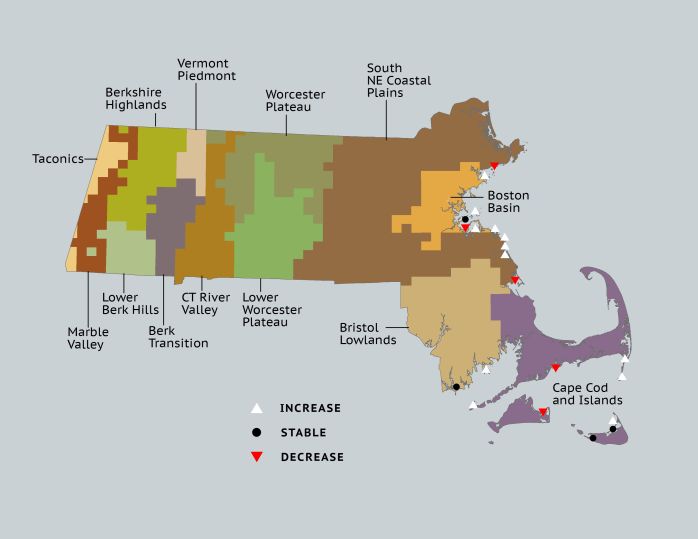Find a Bird
Snowy Egret
Egretta thula

Very local and likely declining
Action/monitoring needed
State Wildlife Action Plan listed
“When she comes to the display of egret plumes, artfully arranged and centrally placed, she pauses. So do many women. For, after all, what can be more ethereally and fantastically lovely?” – Virginia Woolf, The Plumage Bill
Perhaps no bird was as sought after during the decades of plume plundering as the Snowy Egret. The word “egret” originates from the French word aigrette, which is the term still used to refer to the long, elegant breeding plumes that these and other egrets wear during the breeding season. A relative newcomer to our avian landscape, Snowy Egrets began to rapidly expand their range after receiving federal protection in 1916, and Massachusetts hosted the first breeders in 1955 (Petersen & Meservey 2003). Since then, this species has established itself as a regular breeder at several of the Commonwealth’s offshore islands.
Historic Status
Snowy Egrets were prized for their plumes, which, according to the Distribution and Migration of North American Herons in 1910, were “selling for more than their weight in gold” (Cooke 1913), Snowy Egrets vanished in great numbers during the late 1800s. A few “accidental stragglers,” in the words of Edward Howe Forbush (Forbush 1925), visited Massachusetts during his time, with specimen takes recorded in Boston in 1862, on Hummock Pond on Nantucket by a member of one of the life saving stations on the island in 1882, and in Northampton in 1887 (Forbush 1925). Never known to breed north of Cape May, New Jersey, such vagrants were typically post breeding northward wanderers. After 1917, Forbush acknowledged an increase in these sightings, but warned that the species could also be confused with the Little Blue Heron (Forbush 1925). The Snowy Egret, though, was clearly on its way to recovery following passage of the Weeks-McLean Act of 1913, which forbade the transport of bird plumage, as well as the Migratory Bird Treaty Act of 1918, which gave the species full protection. By 1955, a nest at Quivet Neck, East Dennis, heralded the arrival of the Snowy Egret as a breeder in Massachusetts (Petersen & Meservey 2003).
Atlas 1 Distribution
Snowy Egrets were showing promising signs of additional recovery in Atlas 1. Although the species was found only at coastal heron colonies, those colonies were spread fairly evenly along the state’s coastline. A couple of Coastal Plains blocks in Plymouth and Essex Counties complemented the 2 Confirmed blocks in the Harbor Islands of the Boston Basin. The Probable block in the extreme southwest of the Bristol/Narragansett Lowlands was the only breeding evidence in that ecoregion, but nearby Cape Cod and the Islands hosted 6 different occupied blocks.
Atlas 2 Distribution and Change
The smaller of the state’s two white egrets and the wearer of the “golden slippers” that bring smiles to the faces of greenhead-fly-swarmed birders in the great salt marshes of the Bay State made small but noticeable gains in Atlas 2. Snowy Egrets did lose a few of their historic nesting sites (such as the Clark’s Island heronry in Plymouth), but expansion outpaced these losses, and Snowy Egret appeared in Atlas 2 to be a steadily increasing breeding species.
Atlas 1 Map

Atlas 2 Map

Atlas Change Map

Ecoregion Data
Atlas 1 | Atlas 2 | Change | ||||||
Ecoregion | # Blocks | % Blocks | % of Range | # Blocks | % Blocks | % of Range | Change in # Blocks | Change in % Blocks |
Taconic Mountains | 0 | 0.0 | 0.0 | 0 | 0.0 | 0.0 | 0 | 0.0 |
Marble Valleys/Housatonic Valley | 0 | 0.0 | 0.0 | 0 | 0.0 | 0.0 | 0 | 0.0 |
Berkshire Highlands | 0 | 0.0 | 0.0 | 0 | 0.0 | 0.0 | 0 | 0.0 |
Lower Berkshire Hills | 0 | 0.0 | 0.0 | 0 | 0.0 | 0.0 | 0 | 0.0 |
Vermont Piedmont | 0 | 0.0 | 0.0 | 0 | 0.0 | 0.0 | 0 | 0.0 |
Berkshire Transition | 0 | 0.0 | 0.0 | 0 | 0.0 | 0.0 | 0 | 0.0 |
Connecticut River Valley | 0 | 0.0 | 0.0 | 0 | 0.0 | 0.0 | 0 | 0.0 |
Worcester Plateau | 0 | 0.0 | 0.0 | 0 | 0.0 | 0.0 | 0 | 0.0 |
Lower Worcester Plateau | 0 | 0.0 | 0.0 | 0 | 0.0 | 0.0 | 0 | 0.0 |
S. New England Coastal Plains and Hills | 2 | 0.7 | 18.2 | 5 | 1.8 | 29.4 | 2 | 0.9 |
Boston Basin | 2 | 3.6 | 18.2 | 4 | 7.1 | 23.5 | 2 | 3.6 |
Bristol and Narragansett Lowlands | 1 | 0.9 | 9.1 | 2 | 1.8 | 11.8 | 1 | 1.0 |
Cape Cod and Islands | 6 | 4.4 | 54.5 | 6 | 4.2 | 35.3 | 2 | 1.7 |
Statewide Total | 11 | 1.1 | 100.0 | 17 | 1.6 | 100.0 | 7 | 0.8 |
Notes
Two surveys by the Massachusetts NHESP showed a decrease in the number of Snowy Egret breeding pairs from 627 to 401, from 1995 to 2008, respectively (Melvin 2010). There was some instability in the occupied colonies, however, with several small colonies reflecting nominal increases, and 3 new colonies located. These small gains were unfortunately offset by large losses at Kettle Island in Salem, Middle Brewster Island in Boston Harbor, and Sarah Island in Hingham.



